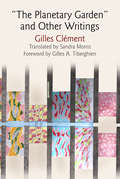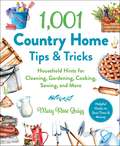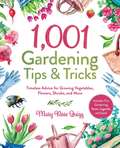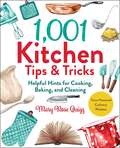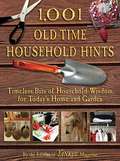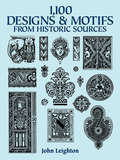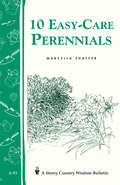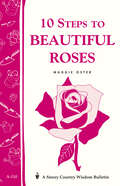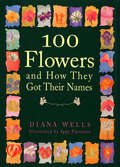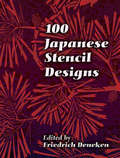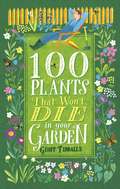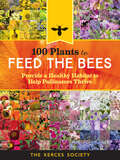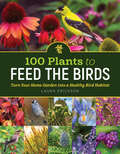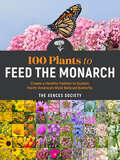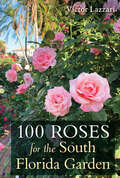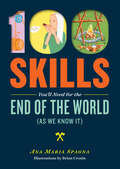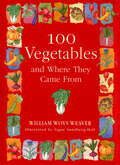- Table View
- List View
"The Planetary Garden" and Other Writings (Penn Studies in Landscape Architecture)
by Gilles ClémentCelebrated landscape architect Gilles Clément may be best known for his public parks in Paris, including the Parc André Citroën and the garden of the Musée du Quai Branly, but he describes himself as a gardener. To care for and cultivate a plot of land, a capable gardener must observe in order to act and work with, rather than against, the natural ecosystem of the garden. In this sense, he suggests, we should think of the entire planet as a garden, and ourselves as its keepers, responsible for the care of its complexity and diversity of life."The Planetary Garden" is an environmental manifesto that outlines Clément's interpretation of the laws that govern the natural world and the principles that should guide our stewardship of the global garden of Earth. These are among the tenets of a humanist ecology, which posits that the natural world and humankind cannot be understood as separate from one another. This philosophy forms a thread that is woven through the accompanying essays of this volume: "Life, Constantly Inventive: Reflections of a Humanist Ecologist" and "The Wisdom of the Gardener." Brought together and translated into English for the first time, these three texts make a powerful statement about the nature of the world and humanity's place within it.
(Co)Designing Hope: Aqueous Landscapes in Transition
by Laura CiprianiExtreme weather events, droughts, floods, shifts in precipitation and temperature patterns, melting glaciers, sea-level rise, water salinization, and more generally, changes in the water cycle remind us that the climate crisis is mostly a water crisis. Perhaps even more serious is a crisis of imagination connected with thought and with creative, far-sighted action able to combine the visionary and the pragmatic. A response to these two crises can be provided by the disciplines of landscape architecture: these have always featured a plural, collective approach that comprises or originates from living systems and natural forces, on the involvement of human and nonhuman communities in the design process, and the inclusion of the time variable in future plans—without neglecting the necessary flexibility of creative and pragmatic thinking. How can landscape design and different forms of collaboration open new doors to face climate and water challenges? What hopes can spring from collective design in its broader meaning?This book sets out notions and ideas on water landscapes and (co)designed practices, identifying what hopeful routes might be taken for the three states of aqueous landscapes in transition—liquid, solid, and gas. The chapters show different scales and levels of design and collaborative practices: from large and governmental projects to small bottom-up interventions; from creative collaboration among designers to traditional community design; from participatory processes to nature as a co-designer for tackling the climate crisis. People, animals, plants, water, ice, fog, clouds, wind, sand, and rocks—all contribute to the cosmos’ landscape symphony, and designing together can become a seed of hope to listen and embrace the Earth’s climate changes.
(Re)Generating Inclusive Cities: Poverty and Planning in Urban North America
by Dan Zuberi Ariel Judith TaylorAs suburban expansion declines, cities have become essential economic, cultural and social hubs of global connectivity. This book is about urban revitalization across North America, in cities including San Francisco, Toronto, Boston, Vancouver, New York and Seattle. Infrastructure projects including the High Line and Big Dig are explored alongside urban neighborhood creation and regeneration projects such as Hunters Point in San Francisco and Regent Park in Toronto. Today, these urban regeneration projects have evolved in the context of unprecedented neoliberal public policy and soaring real estate prices. Consequently, they make a complex contribution to urban inequality and poverty trends in many of these cities, including the suburbanization of immigrant settlement and rising inequality. (Re)Generating Inclusive Cities wrestles with challenging but important questions of urban planning, including who benefits and who loses with these urban regeneration schemes, and what policy tools can be used to mitigate harm? We propose a new way forward for understanding and promoting better urban design practices in order to build more socially just and inclusive cities and to ultimately improve the quality of urban life for all.
(Re)designing the Continuum of Care for Older Adults: The Future of Long-Term Care Settings
by Farhana Ferdous Emily RobertsThis book broadens the visioning on new care environments that are designed to be inclusive, progressive, and convergent with the needs of an aging population. The contents cover a range of long-term care (LTC) settings in a single collection to address the needs of a wide audience.Due to the recent COVID-19 pandemic, rethinking the spatial design of care facilities in order to prepare for future respiratory and contagious pathogens is one of the prime concerns across the globe, along with social connectedness and autonomy in care settings. This book contributes to the next generation of knowledge and understanding of the growing field of the design of technology, programs, and environments for LTC that are more effective in infection prevention and control as well as social connectedness. To address these issues, the chapters are organized in four sections: Part I: Home- and community-based care; Part II: Facility-based care; Part III: Memory care and end-of-life care; and Part IV: Evidence-based applied projects and next steps. (Re)designing the Continuum of Care for Older Adults: The Future of Long-Term Care Settings is an essential resource for researchers, practitioners, educators, policymakers, and students associated with LTC home and healthcare settings. With diverse topics in theory, substantive issues, and methods, the contributions from notable researchers and scholars cover a range of innovative programming, environments, and technologies which can impact the changing needs and support for older adults and their families across the continuum of care.
1,001 Country Home Tips & Tricks: Household Hints for Cleaning, Gardening, Cooking, Sewing, and More (1,001 Tips & Tricks)
by Mary Rose QuiggOver 1,000 Tips for Gardening, Country Cooking, Saving Money, DIY Cleaning Solutions, Home Remedies, and More! This comprehensive collection of practical tips covers all aspects of keeping a country home, from painting a wall to removing wine stains, making perfect pastry to making your own window cleaner. In addition, find advice for cleaning carpets, making jam, wallpapering, knitting, sewing, and more! Woven throughout are poems and proverbs, legends and lore, making this an enjoyable read and a perfect housewarming gift. "Crisp limp lettuce and celery by placing in a pan of cold water for an hour with slices of raw potato.""If an aluminum pan has become discolored, boil some apple peel in it for a few minutes, then rinse and dry.""Tighten up sagging cane seats of chairs by scrubbing both the top and underside with hot soapy water. Rinse in cold salt water.""Sprinkle salt on paths and brickwork crevices to get rid of weeds and grass.""A needle can be threaded more easily if a little hairspray, starch, or beeswax is put on the end of the thread.""Sage tea is a valuable tonic that stimulates the circulation and soothes a persistent cough." Complete with lovely color illustrations throughout, this is a delightful and useful read.
1,001 Gardening Tips & Tricks: Timeless Advice for Growing Vegetables, Flowers, Shrubs, and More (1,001 Tips & Tricks)
by Mary Rose QuiggOver 1,000 Tips for Planting Vegetables, Flowers, Houseplants, Shrubs, Herbs, and Trees! This comprehensive collection of practical tips covers all aspects of gardening, from flowers and houseplants to planting shrubs, vegetables, herbs, and trees. In addition, find advice for dealing with garden pests, learn about the tools that will make your life much easier, and find valuable ways to avoid the aches and pains that often go along with the hard work of gardening. Woven throughout are poems and proverbs, legends and lore, making this an enjoyable read and a perfect gift for the gardener in your life. "Put broken eggshells in a watering can, fill with water, and leave overnight. This will extract the nutrients making an excellent and cheap plant feed.""To improve the growth of leeks, add a little soot to the soil.""Weeding between onion rows should be done by hand, as hoeing will damage the shallow roots.""An old wheel rim makes an ideal storage place for a garden hose when not in use. Hang on a garage or shed wall.""For organic insecticide spray, boil a whole bulb of chopped garlic until it's soft. Put it into 1 gallon of water and add 1 tablespoon of biodegradable detergent. Leave for a day, strain, and use as required." Full of fascinating tidbits and brilliant suggestions, this book may transform the way you garden! Complete with lovely color illustrations throughout, this is a delightful and useful read for new and seasoned gardeners alike.
1,001 Kitchen Tips & Tricks: Helpful Hints for Cooking, Baking, and Cleaning (1,001 Tips & Tricks)
by Mary Rose QuiggSimple, practical, and inspiring tips for cooking, baking, and cleaning!The kitchen is the &“hub&” of any house. With this compilation of helpful hints, you can keep it running smoothly. Find hacks for the care of kitchen appliances, utensils, and cooking equipment to extend their life span. Discover easy ways to improve and simplify your cooking and baking and advice for saving money and making your groceries last longer. Natural products are used wherever appropriate to encourage an environmentally friendly home.Put a paper towel in with baked goods when freezing them. The paper absorbs the moisture and prevents freezer burns.Place a wooden spoon across the pot when cooking pasta and it will not boil over. For fluffier, whiter rice, add 1 teaspoon lemon juice per 2 pints water. To add extra flavor and nutrition to rice, cook it in liquid reserved from cooking vegetables. When making soup stock add 1 tablespoon white vinegar to help extract all the calcium from the bones being used. There will be no vinegar taste. Poke a hole in the middle of hamburgers while shaping them. The burgers will cook faster and the holes will disappear when done. Instead of flouring the rolling pin, chill the rolling pin in the freezer and the dough will not stick.Many of the hints found here are the product of tradition passed from one generation to another. Interspersed throughout are poems and proverbs, as well as delightful illustrations.
1,001 Old-Time Household Hints: Timeless Bits of Household Wisdom for Today's Home and Garden
by Yankee MagazineWonder what Grandma would have used to clean greasy kitchen walls? Cure a sore throat? Conquer insect pests in her vegetable garden? Wonder no longer! Whatever your grandma did to fix and maintain things around the house and garden, it probably worked. That's because the old ways are often the best ways when it comes to solutions for everyday problems, ideas for saving time, and handy advice for getting the job done. And that's where 1,001 Old-Time Household Hints comes in. Find the best hints, tips, and secrets for everything from cooking, cleaning, and home maintenance to pet care, gardening, and holiday celebrations. You'll also find ways to adapt and improve some old-time methods. Discover an amazing variety of useful and clever ideas, including how to: Clean copper pans, using buttermilk and salt Make real sourdough bread the way the pioneers did Fight wrinkles and create kissable lips Use natural ingredients to repair your hair Create your own unique perfume Organize common space in your home Use ivory soap for polishing silver and insect control Safely separate drinking glasses that have been stuck together And more! With 1,001 Old-Time Household Hints on your kitchen table or nightstand, you're always in the good company of an old-timer who's ready to dispense a helpful hint, encouraging word, or sage secret at the turn of a page. 310 color photographs
1,100 Designs and Motifs from Historic Sources (Dover Pictorial Archive)
by John LeightonHundreds of beautifully rendered, royalty-free images painstakingly adapted from a host of design traditions: primitive tribal, Egyptian, Greek, Etruscan, Roman, Chinese, Japanese, Persian, Byzantine, French Renaissance and more. Also, decorative motifs derived from metalwork, heraldic ornament, floral vignettes, letters, other elements. Invaluable sourcebook for artists, craftworkers and decorative art enthusiasts.
10 Easy-Care Perennials
by Marcella ShafferIf you love to garden but don't have much time to spend weeding, watering, and fussing over your plants, perennials are the perfect flowers for you. Most perennials self-propagate and multiply on their own, increasing in beauty and size each year. They are also less expensive and time-consuming than annuals over the long term, because you don't have to buy new plants each year. But choosing the best plants from today's selection of literally thousands of perennials is enough to stump any flower enthusiast, let alone a beginning gardener. This booklet will introduce you to 10 beautiful perennials that are undemanding, wonderfully versatile, and adaptable to a variety of growing conditions. They're not particularly fussy about soil conditions, and they can tolerate both drought and overwatering, as long as they have adequate drainage. These wonders of the perennial world grow quickly, require little maintenance, and reward you with a kaleidoscope of color and gorgeous foliage year after year.
10 Steps to Beautiful Roses: Storey Country Wisdom Bulletin A-110 (Storey Country Wisdom Bulletin Ser.)
by Maggie OsterGROW BEAUTIFUL ROSES IN 10 SIMPLE STEPS!The rose has inspired artists, writers, and composers for centuries. Now you can join the ranks of those inspired gardeners who cultivate roses in their home gardens. Whether you’re a novice gardener wanting to know the basics or a seasoned horticulturalist looking up tips on improving your blooms, Maggie Oster’s expert advice offers all the know-how you’ll need. Her ten simple steps ensure beautiful, fragrant roses with minimum fuss and maximum yield. Maggie Oster is a freelance author, photographer, and horticulturalist. She is the author of several books, including The Herbal Palate Cookbook and Herbal Vinegar.
10,000 Garden Questions Answered by 20 Experts
by Marjorie J. DietzAnswers on: soils, fertilizers, landscaping, ornamental plants, trees, shrubs, vines, bulbs, tubers, corms, roses, perennials, annuals, biennials, lawns, vegetables, fruits, house plants, weeds, etc.
10,001 Ways to Live Large on a Small Budget
by The Writers of Wise BreadFilled with savvy tips on how to live, eat, shop, and have fun on a small budget, 10,001 Ways to Live Large on a Small Budget is a compilation of the juiciest tips from the #1 personal finance blog WiseBread.com, including: 9 Ways to See the World For Free 12 Ways to Live Rent or Mortgage Free 6 Steps to Eliminating Your Debt Painlessly 7 Ways to Score Free Food Bulk Buying 101 10 Killer Ways to Feel Like a Million Bucks 6 Horrible Financial Products to Avoid 7 Beauty Secrets that Cost Almost Nothing 50 Ways to Get the Most Out of Health Care 12 Fabulous Frugal Party Ideas Too many frugal living books focus on the negative, throwing around words such as "sacrifice" and "responsibility" like there was a fire sale at the Boring Store. But the writers at Wise Bread believe the key to financial wellness isn't a ramen-eating, vacation-skipping, fun-depriving life. Far from it. The best way to ensure that readers will stick to a budget is to help them create a lifestyle that is as much fun as it is practical.
100 Best Cannabis Strains: A Pocket Guide for Medicinal and Recreational Use
by Michael BloodAn in-depth guide to finding the right cannabis strain for your needs—both on a recreational and medicinal level. With an ever-increasing number of states legalizing the use of marijuana, the buyer is faces with the question: &“Which strain is going to give me the best results?&” Thankfully, in 100 Best Cannabis Strains, you will be able to find all the answers to your questions. With in-depth details on each strain, readers will be able to determine which is right for them. Having trouble sleeping? Consider Orange Tree. Looking to relax? Give OGKush a try. In addition to images for each strain, readers will be supplied pertinent information to best help find the perfect remedy. Such details include: Strain Ratio (Sativa/Indica)Amount of THC and CBDPotential Side EffectsMedicinal BenefitsAnd much more While there are literally thousands of strains—and more coming out each day—this pocket guide will help you navigate through all that cannabis has to offer. Whether it&’s Bubba Kush, Charlotte&’s Web, Cherry Pie, White Widow, Jack Herer, Confidential Cheese, or Granddaddy Purple, 100 Best Cannabis Stains is your one-stop-shop to getting the most out of your cannabis.
100 Flowers and How They Got Their Names
by Diana Wells Ippy PattersonIllustrations by Ippy Patterson. From Baby Blue Eyes to Silver Bells, from Abelia to Zinnia, every flower tells a story. Gardening writer Diana Wells knows them all. Here she presents one hundred well-known garden favorites and the not-so-well-known stories behind their names. Not for gardeners only, this is a book for anyone interested not just in the blossoms, but in the roots, too.
100 Japanese Stencil Designs (Dover Pictorial Archive)
by Friedrich DenekenThe natural Japanese affinity for decorative art is apparent in this striking collection of exquisite stencil designs. A centuries-old tradition of capturing nature in striking floral and wildlife motifs is reflected in the graceful shapes and lovely lines of more than 100 illustrations. Lush blossoms, bamboo branches, butterflies, birds on the wing, and rustic country homes, among other subjects long associated with Japanese art, are boldly printed in black and white.Ready for use as patterns for wallpaper, textiles, graphics, and needlework, these delicate royalty-free images are ideal for a host of modern decorative and graphic needs.
100 Plants That Won't Die in Your Garden
by Geoff TibballsStocking a garden with plants can be an expensive business, so there are few things more frustrating than when the prized specimen for which you have paid a king's ransom either online or at a garden centre shrivels up and dies within a year or so of purchase. If you can prove that the plant was half-dead when it arrived, you may able to obtain a refund from some online retailers, but for the most part you have to put it down to experience and make a firm mental note not to buy fussy plants in future.The problem is that many websites and catalogues claim that everything they stock is easy to grow. Herbaceous perennials are a particular minefield. Too often you are told that a certain plant 'will come back year after year' without fail when in reality it is either so tender that the only chance of it surviving an average British winter is in a greenhouse or it is a short-lived perennial that is unlikely to flourish beyond two years anyway - and even then only if the local slugs and snails are on a diet. This book cuts through the horticultural sales pitches by listing 100 plants which, for little care beyond the essential watering at planting time, can reliably be expected to thrive in just about any garden. These plants are all but indestructible - pests give them a wide berth, they will prosper in any reasonable garden soil and will withstand anything that the UK climate throws at them. Divided into sections for shrubs, conifers, climbers, perennials, grasses, annuals, alpines and bulbs and with each entry having a Value For Money (VFM) rating out of 10, this easy-to-use guide will prove invaluable not only for the new gardener but also for old hands who are fed up with wasting time and money on plants that all too rapidly lose the will to live. With these suggestions, you can be assured of year-round colour and interest in your garden for the minimum of effort.
100 Plants That Won't Die in Your Garden
by Geoff TibballsStocking a garden with plants can be an expensive business, so there are few things more frustrating than when the prized specimen for which you have paid a king's ransom either online or at a garden centre shrivels up and dies within a year or so of purchase. If you can prove that the plant was half-dead when it arrived, you may able to obtain a refund from some online retailers, but for the most part you have to put it down to experience and make a firm mental note not to buy fussy plants in future.The problem is that many websites and catalogues claim that everything they stock is easy to grow. Herbaceous perennials are a particular minefield. Too often you are told that a certain plant 'will come back year after year' without fail when in reality it is either so tender that the only chance of it surviving an average British winter is in a greenhouse or it is a short-lived perennial that is unlikely to flourish beyond two years anyway - and even then only if the local slugs and snails are on a diet. This book cuts through the horticultural sales pitches by listing 100 plants which, for little care beyond the essential watering at planting time, can reliably be expected to thrive in just about any garden. These plants are all but indestructible - pests give them a wide berth, they will prosper in any reasonable garden soil and will withstand anything that the UK climate throws at them. Divided into sections for shrubs, conifers, climbers, perennials, grasses, annuals, alpines and bulbs and with each entry having a Value For Money (VFM) rating out of 10, this easy-to-use guide will prove invaluable not only for the new gardener but also for old hands who are fed up with wasting time and money on plants that all too rapidly lose the will to live. With these suggestions, you can be assured of year-round colour and interest in your garden for the minimum of effort.
100 Plants to Feed the Bees: Provide a Healthy Habitat to Help Pollinators Thrive
by The Xerces SocietyThe international bee crisis is threatening our global food supply, but this user-friendly field guide shows what you can do to help protect our pollinators. The Xerces Society for Invertebrate Conservation offers browsable profiles of 100 common flowers, herbs, shrubs, and trees that support bees, butterflies, moths, and hummingbirds. The recommendations are simple: pick the right plants for pollinators, protect them from pesticides, and provide abundant blooms throughout the growing season by mixing perennials with herbs and annuals! 100 Plants to Feed the Bees will empower homeowners, landscapers, apartment dwellers — anyone with a scrap of yard or a window box — to protect our pollinators.
100 Plants to Feed the Birds: Turn Your Home Garden into a Healthy Bird Habitat
by Laura EricksonPlants are one of the healthiest and most helpful ways to attract and support a wide variety of birds. In this colorful easy-reference guide, birding expert Laura Erickson details the 100 best native plants for providing food and habitat to backyard and migrating birds across North America.
100 Plants to Feed the Monarch: Create a Healthy Habitat to Sustain North America's Most Beloved Butterfly
by The Xerces SocietyThe plight of the monarch butterfly has captured public attention and sparked widespread interest in helping to save their dwindling populations. In this in-depth portrait of the monarch butterfly—covering its life cycle, its remarkable relationship with milkweed, its extraordinary migration, and the threats it now faces due to habitat loss and climate change—detailed instructions on how to design and create monarch-friendly landscapes are enriched by guidance on observing and understanding butterfly behavior and habits. Following the model of their previous best-selling book, 100 Plants to Feed the Bees, the Xerces Society provides at-a-glance profiles of the plant species that provide monarchs with nourishment. The plants, which are all commercially available, range from dozens of species of milkweed—the only food of monarch caterpillars—to numerous flowering plants, shrubs, and trees that provide nectar for the adult butterfly, including those that bloom in late season and sustain monarchs in their great migration. Gorgeous photographs of monarchs and plants, plus illustrations, maps, and garden plans, make this a visually engaging guide.
100 Roses for the South Florida Garden
by Victor LazzariTried and true varieties for tropical FloridaContrary to common belief, many varieties of roses can flourish in Florida’s heat and humidity. A much-needed guide for both home gardeners and landscape professionals, 100 Roses for the South Florida Garden equips readers with the knowledge to successfully grow this popular plant in the state’s tropical climate. Rose connoisseur Victor Lazzari surveys the history of the rose; outlines the main classifications of roses; explains how to best cultivate the flower in the South Florida environment; and offers advice on designing thoughtful, eco-friendly, visually spectacular gardens with roses in this region. Lazzari then provides an illustrated compendium of 100 varieties of roses that work well in South Florida. Each entry contains a beautiful full-color photograph, a brief history of the rose variety, and notes on the variety’s preferences. Complete with a thorough list of local rose retailers and organizations, this book is filled with useful information that has previously been difficult for Florida residents to locate. New gardeners and dedicated rosarians alike will delight in this approachable, eye-catching resource for finding and growing roses that thrive in the southernmost part of the state.
100 Skills You'll Need for the End of the World (as We Know It)
by Brian Cronin Ana Maria SpagnaFrom celestial navigation to sharpening blades, Ana Maria Spagna outlines 100 skills you’ll find indispensable for life after an apocalyptic global catastrophe. She covers obvious needs like first aid and farming, while also providing suggestions on how to build a safe and culturally rich community through storytelling and music making. Full of quirky illustrations by Brian Cronin, this book will provoke surprise, debate, and laughter as it leads you to greater self-reliance and joy — whatever the future brings.
100 Things Every Homeowner Must Know
by Editors Of Family HandymanThe Family Handyman's 100 Things Every Homeowner Must Know gives you the knowledge you need to be a better homeowner. You'll make informed decisions, avoid frustrations and save thousands over the life of your home.The Family Handyman's 100 Things Every Homeowner Must Know gives you the knowledge you need to be a better homeowner. You'll make informed decisions, avoid frustrations and save thousands over the life of your home. Here's just a small sample of what's inside: The smartest thing you can do before going on vacation Push a button and save $100 Be ready for any natural disaster Make burglars bypass your house The most effective way to cut heating and cooling costs Clever shortcuts for home maintenance--indoors and out Keep mice, ants and other invaders out of your house Boost curb appeal without remodeling What to do when the power goes out The most common--and costly--homeowner mistakes Eliminate noises, odors and other household irritations Grow the best lawn on the block Secret weapons pros use for easy, instant repairs Make appliances last years longer The key to drip-free faucets Make your mower start right up--every time Cures for damp basements Exterminate mold and mildew Pick a paint color you'll love Get faster downloads and better TV quality Stop peeling paint Plus, incredibly easy repairs for appliances, plumbing, flooring, walls, furniture and more!
100 Vegetables and Where They Came From
by William Woys Weaver Signe Sundberg-HallA perfect leek from France. Flavorful zucchini from Italy. An infamous potato from Ireland, and a humble lentil from Ethiopia. 100 Vegetables offers a veritable cornucopia of vegetables and stories from around the world--from Argentina to Zimbabwe, from Australia to the United States. William Woys Weaver--veggie connoisseur, gardener, and historian--guides us through a range of peppers, potatoes, peas, gourds, onions, tomatoes, greens, and a whole lot more. Not every carrot is the same. All beans aren't equal. Take the Petaluma Gold Rush bean, a rugged legume, grown for over 150 years and brought to California by an American whaler from Peru. Or the violet carrot, which the Greeks brought back from India following the conquests of Alexander the Great. Mixing history, culinary suggestions, practical information, and personal anecdotes, Weaver introduces us to unusual heirloom vegetables as well as to common favorites. He provides answers to general questions, such as the difference between a yam and a sweet potato, and presents lively portraits of one hundred vegetable varieties, which he's grown and harvested in his own kitchen garden. Organized alphabetically by common name, 100 Vegetables includes beautifully detailed drawings throughout and a helpful appendix of seed resources.
